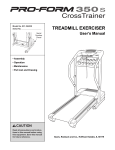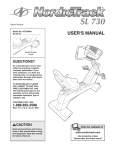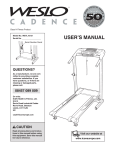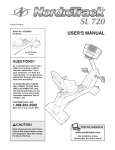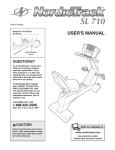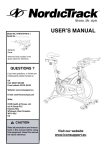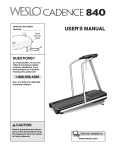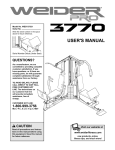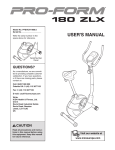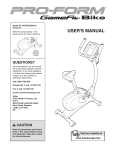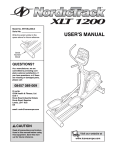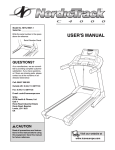Download USER`S MANUAL
Transcript
ORDERING REPLACEMENT PARTS To order replacement parts, contact the ICON Health & Fitness, Ltd. office, or write: ICON Health & Fitness, Ltd. Unit 4 Revie Road Industrial Estate Revie Road Beeston Leeds LS11 8JG UK Class HC Fitness Product Model No. NTEVEX99830 Serial No. Tel: 08457 089 009 Fax: 0 (444) 113 387 7125 Serial Number Decal When ordering parts, please be prepared to give the following information: • the MODEL NUMBER of the product (NTEVEX99830) QUESTIONS? • the NAME of the product (NordicTrack® SL 850 exercise cycle) As a manufacturer, we are committed to providing complete customer satisfaction. If you have questions, or if there are missing parts, please call: • the SERIAL NUMBER of the product (see the front cover of this manual) • the KEY NUMBER and DESCRIPTION of the part(s) (see page 25) 08457 089 009 Or write: ICON Health & Fitness, Ltd. Unit 4 Revie Road Industrial Estate Revie Road Beeston Leeds LS11 8JG email: [email protected] CAUTION Read all precautions and instructions in this manual before using this equipment. Keep this manual for future reference. Part No. 202611 R1003A Printed in China © 2003 ICON Health & Fitness, Inc. USER'S MANUAL 18 57 47 21 23 2 30 TABLE OF CONTENTS 78 83 33 96 49 1 33 28 24 50 76 61 28 92 90 22 46 89 83 45 83 75 87 71 20 70 38 71 59 98 98 8 83 51 51 72 71 69 74 37 57 83 84 75 36 95 75 5 64 68 44 48 57 84 33 77 90 34 68 63 35 32 57 33 91 85 29 88 25 63 67 39 97 31 88 IMPORTANT PRECAUTIONS . . . . . . . . . . . . . . . . . . . . . . . . . . . . . . . . . . . . . . . . . . . . . . . . . . . . . . . . . . . . .3 BEFORE YOU BEGIN . . . . . . . . . . . . . . . . . . . . . . . . . . . . . . . . . . . . . . . . . . . . . . . . . . . . . . . . . . . . . . . . . . .4 ASSEMBLY . . . . . . . . . . . . . . . . . . . . . . . . . . . . . . . . . . . . . . . . . . . . . . . . . . . . . . . . . . . . . . . . . . . . . . . . . . .5 HOW TO USE THE CHEST PULSE SENSOR . . . . . . . . . . . . . . . . . . . . . . . . . . . . . . . . . . . . . . . . . . . . . . . . .9 HOW TO OPERATE THE EXERCISE CYCLE . . . . . . . . . . . . . . . . . . . . . . . . . . . . . . . . . . . . . . . . . . . . . . . .11 MAINTENANCE AND TROUBLESHOOTING . . . . . . . . . . . . . . . . . . . . . . . . . . . . . . . . . . . . . . . . . . . . . . . . .23 EXERCISE GUIDELINES . . . . . . . . . . . . . . . . . . . . . . . . . . . . . . . . . . . . . . . . . . . . . . . . . . . . . . . . . . . . . . . .24 PART LIST . . . . . . . . . . . . . . . . . . . . . . . . . . . . . . . . . . . . . . . . . . . . . . . . . . . . . . . . . . . . . . . . . . . . . . . . . . .25 EXPLODED DRAWING . . . . . . . . . . . . . . . . . . . . . . . . . . . . . . . . . . . . . . . . . . . . . . . . . . . . . . . . . . . . . . . . .26 ORDERING REPLACEMENT PARTS . . . . . . . . . . . . . . . . . . . . . . . . . . . . . . . . . . . . . . . . . . . . . . . .Back Cover 50 97 51 57 43 40 94 41 51 3 57 14 13 53 17 55 56 16 53 55 19 53 55 15 55 19 19 56 54 56 54 NordicTrack is a registered trademark of ICON Health & Fitness, Inc. 2 27 56 54 54 19 EXPLODED DRAWING—Model No. NTEVEX99830 R1003A WARNING: To reduce the risk of serious injury, read the following important precautions before using the exercise cycle. 66 62 55 60 60 79 80 55 12 4 80 63 7 6 57 55 79 80 55 6 80 1. Read all instructions in this manual before using the exercise cycle. Use the exercise cycle only as described. 42 9 IMPORTANT PRECAUTIONS 7. Wear suitable clothing when using the exercise cycle; do not wear loose clothing that could become caught on the exercise cycle. Always wear athletic shoes. 2. It is the responsibility of the owner to ensure that all users of the exercise cycle are adequately informed of all precautions. 8. Always keep your back straight when using the exercise cycle. Do not arch your back. 3. Use the exercise cycle indoors on a level surface. Keep the exercise cycle away from moisture and dust. Place a mat under the exercise cycle to protect the floor or carpet. 9. If you feel pain or dizziness whilst exercising, stop immediately and cool down. 10. The pulse sensors are not medical devices. Various factors, including the user's movement, may affect the accuracy of heart rate readings. The pulse sensors are intended only as exercise aids in determining heart rate trends in general. 4. Inspect and properly tighten all parts regularly. Replace any worn parts immediately. 82 57 86 57 5. Keep children under the age of 12 and pets away from the exercise cycle at all times. 73 57 52 51 10 51 81 11 27 58 WARNING: Before beginning this or any exercise program, consult your physician. This is especially important for persons over the age of 35 or persons with pre-existing health problems. Read all instructions before using. ICON assumes no responsibility for personal injury or property damage sustained by or through the use of this product. 58 57 83 11. The exercise cycle is intended for in-home use only. Do not use the exercise cycle in a commercial, rental, or institutional setting. 6. The exercise cycle should not be used by persons weighing more than 115 kg (250 lbs). 58 57 83 93 65 26 57 57 65 93 65 26 3 PART LIST—Model No. NTEVEX99830 BEFORE YOU BEGIN reading this manual, please call our Customer Service Department at 08457 089 009. To help us assist you, please mention the product model number and serial number when calling. The model number is NTEVEX99830. The serial number can be found on a decal attached to the exercise cycle (see the front cover of this manual for the location of the decal). Congratulations for selecting the new NordicTrack® SL 850 exercise cycle. Cycling is one of the most effective exercises for increasing cardiovascular fitness, building endurance, and toning the entire body. The NordicTrack® SL 850 exercise cycle offers an impressive array of features designed to let you enjoy this healthful exercise in the comfort and privacy of your home. Before reading further, please familiarise yourself with the parts that are labeled in the drawing below. For your benefit, read this manual carefully before using the exercise cycle. If you have questions after Water Bottle Holder* Fan Bookrack Console FRONT Seat Seat Knob Pedal/Strap Backrest Wheel Handgrip Pulse Sensor Handlebar RIGHT SIDE REAR Leveling Foot *No water bottle is included. Key No. Qty. 1 2 3 4 5 6 7 8 9 10 11 12 13 14 15 16 17 18 19 20 21 22 23 24 25 26 27 28 29 30 31 32 33 34 35 36 37 38 39 40 41 42 43 44 45 46 47 48 49 50 51 1 1 1 1 1 2 1 1 1 1 1 1 1 1 1 1 2 1 4 1 1 1 1 1 1 1 1 2 1 1 1 2 4 1 1 1 1 1 1 1 1 1 1 1 1 1 1 1 1 2 12 Description Key No. Qty. Frame Upright Pulse Wire Console Seat Rail Pulse Sensor Seat Frame Seat Rail Endcap Seat Seat Knob Seat Carriage Seat Frame Endcap Front Stabiliser Cover Rear Stabiliser Cover Front Stabiliser Rear Stabiliser Wheel Right Pedal Strap Leveling Foot Generator Right Pedal Left Pedal Right Crank Arm Left Crank Arm Left Pedal Strap Left Side Shield Right Side Shield Snap Ring Pulley Magnet Crank Assembly Pulley Spacer Crank Bearing Flywheel “C” Magnet Resistance Cable Spring Resistance Motor Idler Arm Control Board Control Bracket Backrest Frame Wire Harness Flywheel Bracket Clamp Reed Switch/Wire Drive Belt Flywheel Axle M10 x 82mm Bolt Flange Screw Standoff 52 53 54 55 56 57 58 59 60 61 62 63 64 65 66 67 68 69 70 71 72 73 74 75 76 77 78 79 80 81 82 83 84 85 86 87 88 89 90 91 92 93 94 95 96 97 98 # # # # 1 2 8 12 8 20 4 2 4 1 1 5 4 6 1 1 4 2 1 6 1 1 4 6 1 3 2 4 8 1 2 13 2 1 1 1 2 1 3 1 1 2 2 1 1 4 2 3 1 1 1 R1003A Description Seat Carriage Endcap Bolt Set M8 x 40mm Button Screw M8 Split Washer M4 x 38mm Screw M4 x 16mm Screw Carriage Bushing M6 x 50mm Bolt M8 Washer M10 Washer Backrest M10 Nylon Locknut M5 Nylon Locknut M4 x 25mm Screw Backrest Frame Endcap Idler Bolt M8 x 14mm Tapered Bolt M6 Nut Frame RJ14 Outlet M5 Washer Frame RJ14 Bracket Carriage RJ14 Bracket M5 x 16mm Bolt M5 x 16mm Round Head Screw M10 x 43mm Bolt M8 x 35mm Screw M10 x 110mm Button Screw M8 x 25mm Button Screw 1/4” x 16mm Button Screw Carriage RJ14 Outlet M10 x 52mm Button Bolt M6 Nylon Locknut Bumper “J” Bolt Bushing RJ14 Cable M6 x 52mm Bolt M10 Split Washer M8 Nylon Locknut M8 Nylon Jam Nut M6 x 45mm Bolt M10 Flange Nut M5 x 25mm Round Head Screw M4 Washer M4 Push Nut Thrust Washer M6 x 18mm Bolt M6 x 18mm Round Head Screw Hex Key User’s Manual Chest Strap Sensor Unit Note: “#” indicates a non-illustrated part. Specifications are subject to change without notice. See the back cover of this manual for information about ordering replacement parts. 4 25 EXERCISE GUIDELINES ASSEMBLY Fat Burning WARNING: To burn fat effectively, you must exercise at a relatively low intensity level for a sustained period of time. During the first few minutes of exercise, your body uses easily accessible carbohydrate calories for energy. Only after the first few minutes of exercise does your body begin to use stored fat calories for energy. If your goal is to burn fat, adjust the intensity of your exercise until your heart rate is near the lowest number or the middle number in your training zone as you exercise. • Before beginning this or any exercise program, consult your physician. This is especially important for individuals over the age of 35 or individuals with pre-existing health problems. • The pulse sensors are not medical devices. Various factors, including the user's movement, may affect the accuracy of heart rate readings. The pulse sensors are intended only as exercise aids in determining heart rate trends in general. Assembly requires two persons. Place all parts of the exercise cycle in a cleared area and remove the packing materials. Do not dispose of the packing materials until assembly is completed. Assembly requires the included tools and your own adjustable spanner . Use the drawings below to identify the small parts used in assembly. The number in parenthesis below each drawing refers to the key number of the part, from the PART LIST on page 25. The second number refers to the quantity needed for assembly. Note: Some small parts may have been pre-assembled for shipping. If a part is not in the parts bag, check to see if it has been pre-assembled. Aerobic Exercise If your goal is to strengthen your cardiovascular system, your exercise must be “aerobic.” Aerobic exercise is activity that requires large amounts of oxygen for prolonged periods of time. This increases the demand on the heart to pump blood to the muscles, and on the lungs to oxygenate the blood. For aerobic exercise, adjust the intensity of your exercise until your heart rate is near the highest number in your training zone. The following guidelines will help you to plan your exercise program. Remember that proper nutrition and adequate rest are essential for successful results. EXERCISE INTENSITY Whether your goal is to burn fat or to strengthen your cardiovascular system, the key to achieving the desired results is to exercise with the proper intensity. The proper intensity level can be found by using your heart rate as a guide. The chart below shows recommended heart rates for fat burning, maximum fat burning, and cardiovascular (aerobic) exercise. WORKOUT GUIDELINES M8 Split Washer (55)–12 M4 x 16mm Screw (57)–4 M10 Split Washer (88)–2 M8 Washer (60)–4 1/4” x 16mm Button Screw (80)–8 M10 Nylon Locknut (63)–2 M8 x 40mm Button Screw (54)–8 M8 x 25mm Button Screw (79)–4 Each workout should include the following three parts: A warm-up, consisting of 5 to 10 minutes of stretching and light exercise. A proper warm-up increases your body temperature, heart rate, and circulation in preparation for exercise. Training zone exercise, consisting of 20 to 30 minutes of exercising with your heart rate in your training zone. (During the first few weeks of your exercise program, do not keep your heart rate in your training zone for longer than 20 minutes.) A cool-down, with 5 to 10 minutes of stretching. This will increase the flexibility of your muscles and will help to prevent post-exercise problems. To find the proper heart rate for you, first find your age at the bottom of the chart (ages are rounded off to the nearest ten years). Next, find the three numbers above your age; the three numbers are your “training zone.” The lowest number is the recommended heart rate for fat burning; the middle number is the recommended heart rate for maximum fat burning; and the highest number is the heart rate for aerobic exercise. M10 x 52mm Button Bolt (82)–2 M10 x 110mm Button Screw (78)–2 1. Identify the Front Stabiliser (15). Whilst another person lifts the front of the Frame (1), attach the Front Stabiliser to the Frame with four M8 x 40mm Button Screws (54) and four M8 Split Washers (55). 1 1 EXERCISE FREQUENCY To maintain or improve your condition, plan three workouts each week, with at least one day of rest between workouts. After a few months of regular exercise, you may complete up to five workouts each week, if desired. The key to success is make exercise a regular and enjoyable part of your everyday life. 15 55 55 54 24 5 54 2. Whilst another person lifts the rear of the Frame (1), attach the Rear Stabiliser (16) to the Frame with four M8 x 40mm Button Screws (54) and four M8 Split Washers (55). 2 MAINTENANCE AND TROUBLESHOOTING Inspect and properly tighten all parts of the exercise cycle regularly. To clean the exercise cycle, use a soft, damp cloth. Keep liquids away from the console and keep the console out of direct sunlight. 1 16 Locate the Reed Switch (46). Turn the Right Crank Arm (23) until the Magnet (30) is aligned with the Reed Switch. Loosen, but do not remove, the indicated M4 x 16mm Screw (57). Slide the Reed Switch slightly closer to or away from the Magnet. Then, retighten the Screw. Turn the Right Crank Arm for a moment. Repeat until the console displays correct feedback. When the Reed Switch is correctly adjusted, reattach the Right Side Shield (27) and the Right Pedal (21). HOW TO ADJUST THE REED SWITCH If the console does not display correct feedback, the reed switch should be adjusted. To adjust the reed switch, the Right Side Shield (27) must first be removed. Remove the indicated M4 x 25mm Screws (65) from the Left Side Shield (26). 55 55 54 Front View 54 3. Have another person hold the Upright (2) in the position shown. See the inset drawing. Locate the wire extending from the bottom of the Upright. Tie the wire around the ends of the Wire Harness (43) and the Pulse Wire (3) as shown. Carefully pull the wire up through the Upright until the Wire Harness and the Pulse Wire are extending from the top of the Upright. Untie the wire and discard it. Carefully pull the ends of the Wire Harness and the Pulse Wire to remove any slack. 3 43 3 27 46 65 26 23 2 Do not pinch the Wire Harness (43) or the Pulse Wire (3) during this step. 88 Insert the Upright (2) into the Frame (1). Be careful to avoid pinching the Wire Harness (43) or the Pulse Wire (3). Attach the Upright with two M10 x 110mm Button Screws (78) and two M10 Split Washers (88). 30 57 65 78 1 88 Wire HOW TO ADJUST THE DRIVE BELT Next, remove the indicated M5 x 25mm Screw (93) and M4 x 16mm Screws (57) from the Right Side Shield (27). Using an adjustable wrench, turn the Right Pedal (21) counterclockwise and remove it. Turn the Right Crank Arm (23) so that it is pointing toward the front of the exercise cycle, and then slide off the Right Side Shield. If you can feel the pedals slip whilst you are pedaling, even when the resistance is adjusted to the highest level, the Drive Belt (47) may need to be adjusted. To adjust the Drive Belt, you must first remove the right side shield. See HOW TO ADJUST THE REED SWITCH at the left and remove the right side shield. 43 3 4. Have another person hold the Console (4) near the Upright (2). 4 4 6 23 21 Connect the Wire Harness (43) to the wire harness on the Console (4). Connect the Pulse Wire (3) to the pulse wire on the Console. Next, locate the two ground wires that are connected with a screw to the Upright (2). Connect the ground wires to the two smallest wires on the Console. Carefully insert all excess wiring down into the Upright (2). Attach the Console (4) to the Upright with four M4 x 16mm Screws (57). Be careful to avoid pinching the wires. Next, turn the indicated M10 Nylon Locknut (63) until the Drive Belt (47) is properly tightened. Then, reattach the right side shield. 57 3 47 63 43 27 93 57 PULSE SENSOR TROUBLESHOOTING 57 If the chest pulse sensor does not function properly, see CHEST PULSE SENSOR TROUBLESHOOTING on pages 9 and 10. If the handgrip pulse sensor does not function properly, see step 5 on page 14. Ground Wires 2 Do not pinch the wires during this step. 23 6 HOW TO USE PROGRAMS DIRECTLY FROM OUR WEB SITE 7 Begin pedaling to activate the console. 8 See step 1 on page 13. 9 To select the iFIT.com mode, press the iFIT.com button. The indicator above the button will light. Go to your computer and start an internet connection. 4 Start your Web browser, if necessary, and go to our Web site at www.iFIT.com. 5 Follow the desired links on our Web site to select a program. 9 Return to the exercise cycle and begin pedaling. Measure your heart rate if desired. See step 5 on page 14. 10 Turn on the fan if desired. See step 6 on page 14. 11 7 60 60 Monitor your progress with the matrix and the two displays. See step 4 on page 13. Select the iFIT.com mode. 3 5 When the on-screen countdown ends, the program will begin. The program will function in almost the same way as a resistance and pace program (see step 3 on page 15). However, an electronic “chirping” sound will alert you when the resistance setting and/or the target pace setting is about to change. Follow the steps below to use a program from our Web site. 2 5. Attach the Seat (9) to the Seat Frame (7) with four 1/4” x 16mm Button Screws (80) and four M8 Washers (60). When you start the program, an on-screen countdown will begin. Our Web site at www.iFIT.com allows you to play iFIT.com audio and video programs directly from the internet. To use programs from our Web site, the exercise cycle must be connected to your home computer. See HOW TO CONNECT YOUR COMPUTER on page 19. In addition, you must have an internet connection and an internet service provider. A list of specific system requirements is found on our Web site. 1 Follow the on-line instructions to start the program. When you are finished exercising, the console will automatically turn off. 6. Pull the Seat Knob (10) and slide the Seat Carriage toward the rear of the Seat Rail (5). 80 6 63 Have another person hold the Seat Frame (7) near the Seat Carriage (11). Locate the two pulse wires extending from the Seat Frame. Connect each pulse wire to the pulse wire of the same color in the Seat Carriage. Insert the excess wiring up into the Seat Frame, and set the Seat Frame on the Seat Carriage. Attach the Seat Frame with two M10 x 52mm Button Bolts (82) and two M10 Nylon Locknuts (63). Be careful to avoid damaging the pulse wires with the Bolts. 7 Pulse Wires 82 10 11 5 See step 7 on page 14. 7. Attach the Backrest (62) to the Backrest Frame (42) with four 1/4” x 16mm Button Screws (80). Read and follow the on-line instructions for using a program. 7 62 Slide the Backrest Frame (42) onto the Seat Frame (7). Attach the Backrest Frame with four M8 x 25mm Button Screws (79) and four M8 Split Washers (55). 42 55 79 55 55 79 80 7 22 7 8. Identify the Left Pedal (22), which is marked with an “L.” Using an adjustable wrench, firmly tighten the Left Pedal counterclockwise into the Left Crank Arm (24). Tighten the Right Pedal (not shown) clockwise into the Right Crank Arm. Important: Tighten both Pedals as firmly as possible. After using the exercise cycle for one week, retighten the Pedals. For best performance, the Pedals must be kept tightened. 8 your workout. Simply follow your personal trainer’s instructions. HOW TO USE IFIT.COM CD AND VIDEO PROGRAMS 25 22 24 Identify the Left Pedal Strap (25), which is marked with an “L.” Attach the Left Pedal Strap to the Left Pedal (22), and adjust it to the desired position. Attach and adjust the Right Pedal Strap (not shown) in the same way. 9. Make sure that all parts are properly tightened before you use the exercise cycle. Note: After assembly is completed, some extra parts may be left over. Place a mat beneath the exercise cycle to protect the floor. The program will function in almost the same way as a resistance and pace program (see step 3 on page 15). However, an electronic “chirping” sound will alert you when the resistance setting and/or the target pace setting is about to change. To use iFIT.com CDs or videocassettes, the exercise cycle must be connected to your portable CD player, portable stereo, home stereo, computer with CD player, or VCR. See HOW TO CONNECT YOUR CD PLAYER, VCR, OR COMPUTER on pages 18 to 20. To purchase iFIT.com CDs and videocassettes, visit our Web site at www.iFIT.com. Note: If the resistance of the exercise cycle and/or the target pace setting does not change when a “chirp” is heard: Follow the steps below to use an iFIT.com CD or video program. 1 • Make sure that the indicator above the iFIT.com button is lit. • Adjust the volume of your CD player or VCR. If the volume is too high or too low, the console may not detect the program signals. Begin pedaling to activate the console. See step 1 on page 13. 2 • Make sure that the audio cable is properly connected and that it is fully plugged in. Select the iFIT.com mode. To select the iFIT.com mode, press the iFIT.com button. The indicator above the button will light. 3 4 5 See step 4 on page 13. 6 Insert the iFIT.com CD or videocassette. Measure your heart rate if desired. See step 5 on page 14. If you are using an iFIT.com CD, insert the CD into your CD player. If you are using an iFIT.com videocassette, insert the videocassette into your VCR. 7 Press the play button on your CD player or VCR. 8 Turn on the fan if desired. See step 6 on page 14. When you are finished exercising, the console will automatically turn off. See step 7 on page 14. A moment after the play button is pressed, your personal trainer will begin guiding you through 8 Monitor your progress with the matrix and the two displays. 21 HOW TO CONNECT YOUR VCR B. Plug one end of the audio cable into the jack beneath the console. Plug the other end of the audio cable into the adaptor. Plug the adaptor into an RCA Y-adaptor (available at electronics stores). Next, remove the wire that is currently plugged into the AUDIO OUT jack on your VCR and plug the wire into the unused side of the Y-adaptor. Plug the Y-adaptor into the AUDIO OUT jack on your VCR. Note: If your VCR has an unused AUDIO OUT jack, see instruction A below. If the AUDIO OUT jack is being used, see instruction B. If you have a TV with a built-in VCR, see instruction B. If your VCR is connected to your home stereo, see HOW TO CONNECT YOUR HOME STEREO on page 19. A. Plug one end of the audio cable into the jack beneath the console. Plug the other end of the audio cable into the adaptor. Plug the adaptor into the AUDIO OUT jack on your VCR. A B HOW TO USE THE CHEST PULSE SENSOR HOW TO PUT ON THE CHEST PULSE SENSOR CHEST PULSE SENSOR TROUBLESHOOTING The chest pulse sensor consists of two components: the chest strap and the sensor unit. Follow the steps below to put on the chest pulse sensor. If the chest pulse sensor does not function properly, or if the displayed heart rate is excessively high or low, try the troubleshooting steps below. Chest Strap RF OUT CH 3 4 OUT RCA Y-adaptor ANT. IN • Make sure that you are wearing the chest pulse sensor as described at the left. If the chest pulse sensor does not function when positioned as described, move it slightly lower or higher on your chest. ANT. IN VIDEO AUDIO IN • Each time you use the chest pulse sensor, use saline solution such as saliva or contact lens solution to wet the two electrode areas on the sensor unit (see the drawing below). If heart rate readings do not appear until you begin perspiring, re-wet the electrode areas. Tab VIDEO AUDIO IN RF OUT CH 3 4 OUT Adaptor AUDIO OUT RIGHT LEFT Audio Wire removed from Cable AUDIO OUT jack Adaptor Sensor Unit 1 Audio Cable 2 3 20 Buckle Sensor Unit • Make sure that you are within arm’s length of the console. For the console to display heart rate readings, the user must be within arm’s length of the console. See the inset drawing above. Insert the tab on one end of the chest strap through one end of the sensor unit. Press the end of the sensor unit under the buckle on the chest strap. • If you wear the chest pulse sensor and hold the handgrip pulse sensor at the same time, the console may not display your heart rate accurately. Wrap the chest pulse sensor around Logo your chest. Attach the free end of the chest strap to the sensor unit as described above. Adjust the length of the chest strap, if necessary. The chest pulse sensor should be under your clothes, against your skin, and as high under the pectoral muscles or breasts as is comfortable. Make sure that the logo is right-side-up and facing forward. • The chest pulse sensor is designed to work with people who have normal heart rhythms. Heart rate reading problems may be caused by medical conditions such as premature ventricular contractions (pvcs), tachycardia bursts, and arrhythmia. • The operation of the chest pulse sensor can be affected by magnetic interference caused by high power lines or other sources. If it is suspected that magnetic interference may be causing a problem, try relocating your exercise equipment. • If the chest pulse sensor still does not function properly, test the chest pulse sensor in the following way: Pull the sensor unit Electrode Areas away from your body a few inches and locate the two electrode areas on the inner side. Using a saline solution such as saliva or contact lens solution, wet both electrode areas. Return the sensor unit to a position against your chest. Hold the chest pulse sensor Electrode Areas and place your thumbs over the electrode areas as shown. Next, hold the chest pulse sensor near the console. Whilst holding one thumb stationary, begin tapping the other thumb against the electrode area at a rate of about one tap per second. Check the heart rate reading on the console. 9 • If the chest pulse sensor does not function properly after you have followed all of the above instructions, the battery should be replaced in the following way: Locate the battery cover on the back of the sensor unit. Insert a coin into the slot in the cover, turn the cover counterclockwise, and remove the cover. Remove the old battery and insert a new CR 2032 battery. Make sure that the battery is turned so the writing is on top. Replace the battery cover and turn it clockwise to close it. CHEST PULSE SENSOR CARE HOW TO CONNECT YOUR HOME STEREO HOW TO CONNECT YOUR COMPUTER • Thoroughly dry the chest pulse sensor after each use. The chest pulse sensor is activated when the electrode areas are wetted and the chest pulse sensor is put on; the chest pulse sensor shuts off when it is removed and the electrode areas are dried. If the chest pulse sensor is not dried after each use, it may remain activated longer than necessary, draining the battery prematurely. Note: If your stereo has an unused LINE OUT jack, see instruction A below. If the LINE OUT jack is being used, see instruction B. Note: If your computer has a 3.5mm LINE OUT jack, see instruction A. If your computer has only a PHONES jack, see instruction B. A. Plug one end of the audio cable into the jack beneath the console. Plug the other end of the audio cable into the adaptor. Plug the adaptor into the LINE OUT jack on your stereo. A. Plug one end of the audio cable into the jack beneath the console. Plug the other end of the audio cable into the LINE OUT jack on your computer. • Store the chest pulse sensor in a warm, dry place. Do not store the chest pulse sensor in a plastic bag or other container that may trap moisture. A A CD VCR Amp • Do not expose the chest pulse sensor to direct sunlight for extended periods of time. Do not expose the chest pulse sensor to temperatures above 50° C (122° F) or below -10° C (14° F). CR 2032 Battery LINE OUT Audio Cable LINE OUT Adaptor Audio Cable • Do not excessively bend or stretch the sensor unit when using or storing the chest pulse sensor. • Clean the sensor unit using a damp cloth—never use alcohol, abrasives, or chemicals. The chest strap may be hand washed and air dried. LINE OUT B. Plug one end of the audio cable into the jack beneath the console. Plug the other end of the audio cable into the splitter. Plug the splitter into the PHONES jack on your computer. Plug your headphones or speakers into the other side of the splitter. B. Plug one end of the audio cable into the jack beneath the console. Plug the other end of the audio cable into the adaptor. Plug the adaptor into an RCA Y-adaptor (available at electronics stores). Next, remove the wire that is currently plugged into the LINE OUT jack on your stereo and plug the wire into the unused side of the Y-adaptor. Plug the Y-adaptor into the LINE OUT jack on your stereo. B B PHONES CD Audio Cable Splitter VCR Amp Audio Cable Headphones/Speakers LINE OUT RCA Y-adaptor Adaptor Wire removed from LINE OUT jack 10 19 HOW TO CONNECT YOUR PORTABLE STEREO HOW TO CONNECT YOUR CD PLAYER, VCR, OR COMPUTER To use iFIT.com CDs, the exercise cycle must be connected to your portable CD player, portable stereo, home stereo, or computer with CD player. See pages 18 and 19 for connecting instructions. To use iFIT.com videocassettes, the exercise cycle must be connected to your VCR. See page 20 for connecting instructions. To use iFIT.com programs directly from our Web site, the exercise cycle must be connected to your home computer. See page 19 for connecting instructions. Note: If your stereo has an RCA-type AUDIO OUT jack, see instruction A below. If your stereo has a 3.5mm LINE OUT jack, see instruction B. If your stereo has only a PHONES jack, see instruction C. A. Plug one end of the audio cable into the jack beneath the console. Plug the other end of the audio cable into the adaptor. Plug the adaptor into an AUDIO OUT jack on your stereo. HOW TO OPERATE THE EXERCISE CYCLE HOW TO MOVE AND LEVEL THE EXERCISE CYCLE Stand in back of the exercise cycle, and lift the exercise cycle until it can be moved on the front wheels. Move the exercise cycle to the desired location and carefully lower it. Due to the weight of the exercise cycle, use extreme caution whilst moving it. A, B HOW TO CONNECT YOUR PORTABLE CD PLAYER AUDIO OUT RIGHT LEFT Note: If your CD player has separate LINE OUT and PHONES jacks, see instruction A below. If your CD player has only one jack, see instruction B. A. Plug one end of the audio cable into the jack beneath the console. Plug the other end of the audio cable into the LINE OUT jack on your CD player. Plug your headphones into the PHONES jack. A PHONES LINE OUT LINE OUT PHONES Headphones Audio Cable Wheel Adaptor HOW TO ADJUST THE SEAT The seat can be adjusted to the posiSeat Seat tion that is the most Knob comfortable for you. To adjust the seat, pull the seat knob, slide the seat forward or backward, and then release the seat knob. Move the seat forward or backward slightly until the pin on the seat knob snaps into one of the holes in the seat rail. HOW TO ADJUST THE PEDAL STRAPS Audio Cable B. See the drawing above. Plug one end of the audio cable into the jack beneath the console. Plug the other end of the audio cable into the LINE OUT jack on your stereo. Do not use the adaptor. C. Plug one end of the audio cable into the jack beneath the console. Plug the other end of the audio cable into the splitter. Plug the splitter into the PHONES jack on your stereo. Plug your headphones into the other side of the splitter. If the exercise cycle rocks slightly during use, turn the leveling feet under the rear stabiliser until the rocking motion is eliminated. Leveling Foot The pedal straps can be adjusted to the position that is the most comfortable for you. Press the tabs on the pedals, adjust the straps to the desired position, and then release the tabs. C B. Plug one end of the audio cable into the jack beneath the console. Plug the other end of the audio cable into the splitter. Plug the splitter into the PHONES jack on your CD player. Plug your headphones into the other side of the splitter. PHONES Audio Cable Splitter B Headphones PHONES PHONES Audio Cable Splitter Headphones 18 11 Pedal Strap Tab CONSOLE DIAGRAM Left Display Matrix If you have selected heart rate program 2, the letters “PLS” and the current target heart rate setting will flash in the left display. Press the + or – button repeatedly to change the target heart rate setting, if desired. The target heart rate setting can be from 70 to 170 beats per minute. Training Zone Bar 4 The advanced console offers a selection of features designed to make your workouts more enjoyable and effective. When the manual mode of the console is selected, the resistance of the exercise cycle can be changed with the touch of a button. As you exercise, the console will provide continuous exercise feedback. You can even measure your heart rate using the handgrip pulse sensor or the chest pulse sensor. The console also offers six resistance and pace programs. Each program automatically changes the resistance of the exercise cycle and prompts you to increase or decrease your pace as it guides you through an effective workout. In addition, the console features two heart rate programs that automatically change the resistance of the exercise cycle and prompt you to vary your pace to keep your heart rate near a target heart rate as you exercise. The console also features iFIT.com interactive technology. Having iFIT.com interactive technology is like having a personal trainer in your home. Using the included audio cable, you can connect the exercise cycle to your home stereo, portable stereo, computer, or VCR and play special iFIT.com CD and video programs (iFIT.com CDs and videocassettes are available separately). iFIT.com CD and video programs automatically control the resistance of the exercise cycle and prompt you to vary your pace as a personal trainer coaches you through every step of your workout. High-energy music provides added motivation. To purchase iFIT.com CDs and videocassettes, visit our Web site at www.iFIT.com. With the exercise cycle connected to your computer, you can also go to our Web site at www.iFIT.com and access programs directly from the internet. Explore www.iFIT.com for more information. Hold the handgrip pulse sensor. To use a heart rate program, you must wear the chest pulse sensor (see page 9) or use the handgrip pulse sensor (see step 5 on page 14). If you use the handgrip pulse sensor, it is not necessary to hold the handgrips continuously during the program. However, you should hold the handgrips frequently for the program to operate properly. Each time you hold the handgrips, keep your hands on the metal contacts for at least 30 seconds. Note: When you are not holding the handgrips, the letters “PLS” will appear in the right display instead of your heart rate. Note: If there is a sheet of clear plastic on the face of the console, remove it before using the console. FEATURES OF THE CONSOLE the handgrip pulse a sensor, the console will periodically compare your heart rate to the target heart rate setting; if necesb sary, an indicator in the bar will then flash to prompt you to increase or decrease your pace to bring your heart rate closer to the target heart rate setting. If an indicator to the right of the lit indicators is flashing (see drawing a), increase your pace. If an indicator to the left of any lit indicator is flashing (see drawing b), decrease your pace. When no indicator is flashing, your heart rate is near the target heart rate setting. Important: The target heart rate settings are intended only to provide motivation. Your actual heart rate may be slower than the target heart rate settings. Make sure to exercise at a pace that is comfortable for you. 5 The program will continue until the resistance setting for the last segment is shown in the Current Segment column of the matrix and no time remains in the program. Press the Program Start button or begin pedaling to start the program. Heart rate program 1 consists of 20 one-minute segments. One resistance setting and one target heart rate setting are programmed for each segment. (The same resistance setting and/or target heart rate setting may be programmed for two or more consecutive segments.) During the program, the resistance of the exercise cycle will periodically change. Heart rate program 2 is 40 minutes long (you may choose to use only part of the program). The same resistance setting and target heart rate setting are programmed for the entire program. Note: Heart rate programs cannot be stopped and then restarted. If you stop pedaling for several seconds, the program will end. 6 See step 4 on page 13. 7 Turn on the fan if desired. See step 6 on page 14. As you exercise, the Training Zone bar will help you to keep your heart rate near the target heart rate setting for the current segment. The lit indicators in the bar will show your actual pace. Whilst you wear the chest pulse sensor or hold 12 Monitor your progress with the two displays. 8 When the program is finished, the console will automatically turn off. See step 7 on page 14. 17 4 Monitor your progress with the two displays. HOW TO USE HEART RATE PROGRAMS track representing 1/4 mile. As you exercise, the indicators around the track will light in succession until the entire track is lit. The track will then darken and the indicators will again begin to light in succession. HOW TO USE THE MANUAL MODE See step 4 on page 13. 5 Each heart rate program helps you to keep your heart rate near a certain percentage of your maximum heart rate during your workout. (Your maximum heart rate is estimated by subtracting your age from 220. For example, if you are 30 years old, your maximum heart rate is 190.) Heart rate program 1 is designed to keep your heart rate between 50% and 85% of your maximum heart rate whilst you exercise; heart rate program 2 is designed to keep your heart rate near a target heart rate that you choose. Measure your heart rate if desired. See step 5 on page 14. 6 Turn on the fan if desired. See step 6 on page 14. 7 When the program is finished, the console will automatically turn off. Follow the steps below to use a heart rate program. 1 The exercise cycle requires no batteries or external power source. Power is supplied by a generator as you pedal. To activate the console, begin pedaling at a speed of about 3 miles per hour or faster. After a few seconds, the console displays will light. A tone will then sound and the console will be ready for use. 2 Begin pedaling to activate the console. See step 1 on page 13. 2 Select one of the heart rate programs. When the power is turned on, the manual mode will be selected. To select a heart rate program, press the Program Select button repeatedly until “H 1” or “H 2” appears in the right display. 3 Enter your age or a target heart rate. If you have selected heart rate program 1, the word “AGE” and the current age setting will flash in the left display. If you have already entered your age, press the Enter button and go to step 4. If you have not entered your age, press the + or – button repeatedly to enter your age, and then press the Enter button. 16 Select the manual mode. The left display— The left display will show your pedaling speed, the distance you have pedaled, the resistance level of the exercise cycle, and the elapsed time. The display will change from one number to the next every few seconds, as shown by the indicators around the display. Note: Each time the resistance of the exercise cycle changes, the display will show the resistance level. When a program is selected, the display will show the time remaining in the program instead of the elapsed time. Begin pedaling and change the resistance of the exercise cycle as desired. As you pedal, change the resistance of the exercise cycle by pressing the Resistance buttons. There are ten resistance levels. Note: After the Resistance buttons are pressed, it will take a moment for the exercise cycle to reach the selected resistance level. During heart rate programs, the matrix will show a graphic that represents your heart rate. Each time a heartbeat is detected, an additional peak will appear. 3 The Training Zone bar—The Training Zone bar will show your pace and the approximate intensity level of your exercise. For example, if three or four indicators in the bar are lit, the bar shows that your pace is ideal for fat burning. During programs, the Training Zone bar will also prompt you to increase or decrease your pace. When the power is turned on, the manual mode will be selected. If you have selected a program or the iFIT.com mode, reselect the manual mode by pressing the Program Select button repeatedly until a track appears in the matrix. See step 7 on page 14. 1 Begin pedaling to activate the console. 4 The right display—The right display will show your pedaling pace (in revolutions per minute) and the approximate numbers of fat calories and calories you have burned (see FAT BURNING on page 24). The display will change from one number to the next every few seconds, as shown by the indicators. The display will also show your heart rate when you use the handgrip pulse sensor or the chest pulse sensor. Monitor your progress with the matrix, the Training Zone bar, and the two displays. The matrix— When the manual mode or the iFIT.com mode is selected, the matrix will show a 13 Note: The console can display speed and distance in either miles or kilometres. To find which unit of measurement is selected, you must select the console’s user mode. Hold down the Program Select button for about three seconds. The letter “E” for English miles or the letter “M” for metric kilometres will appear in the left display. To change the unit of measurement, press the + button. When your pulse is detected, the Heart Rate indicator above the right display will begin to flash, one or two dashes (– –) will appear in the display, and then your heart rate will be shown. For the most accurate heart rate reading, hold the contacts for at least 15 seconds. Note: If you continue to hold the pulse sensor, the display will show your heart rate for up to 30 seconds. The display will then show your heart rate along with the other modes. Whilst the user mode is selected, press the Program Start button. The left display will then show the total number of hours that the exercise cycle has been used. Press the Program Start button again. The left display will then show the total number of miles pedaled. To exit the user mode, press the Program Select button again. 5 1 2 Measure your heart rate if desired. To use the chest pulse sensor, see page 9. To use the handgrip pulse sensor, follow the instructions below. Note: If you wear the chest pulse sensor and hold the handgrip pulse sensor at the same time, the console will not display your heart rate accurately. 7 When you are finished exercising, the console will automatically turn off. If the pedals are not moved for several seconds, a tone will sound, the console will pause, and the left display will begin to flash. If there are thin sheets of Contacts plastic on the metal contacts on the handgrip pulse sensor, peel off the plastic. To measure your heart rate, hold the contacts; your palms must be resting on the upper contacts, and your fingers must be touching the lower contacts. Avoid moving your hands. If the pedals are not moved for about one minute, the console will turn off, but the displays will not be reset. If the pedals are not moved for about five minutes, the console will turn off and the displays will be reset. Select one of the six resistance and pace programs. When the power is turned on, the manual mode will be selected. To select a resistance and pace program, press the Program Select button repeatedly until “P 1,” “P 2,” “P 3,” “P 4,” “P 5,” or “P 6” appears in the right display. When only three seconds remain in the first segment of the program, both the Current Segment column and the column to the right will flash, a series of tones will sound, and all target pace settings will move one column to the left. The target pace setting for the second segment will then be shown in the flashing Current Segment column and the resistance of the exercise cycle will automatically change to the resistance setting for the second segment. When a resistance and pace program is selected, the matrix will show the first seven target pace settings of the program. The left display will show how long the program will last. Turn on the fan if desired. To turn on the fan at low speed, press the Fan button. Pivot the fan to the desired angle. To turn on the fan at high speed, press the Fan button a second time. To turn off the fan, press the Fan button a third time. Note: If the pedals are not moved for about thirty seconds, the fan will automatically turn off. Begin pedaling to activate the console. See step 1 on page 13. If your heart rate is not shown, make sure that your hands are positioned as described. Be careful not to move your hands excessively or to squeeze the metal contacts too tightly. For optimal performance, clean the metal contacts using a soft cloth; never use alcohol, abrasives, or chemicals. 6 indicator to the a right of the lit indicators is flashing (see drawing a), increase your pace. If an indicator to the left of any lit b indicator is flashing (see drawing b), decrease your pace. When no indicator is flashing, your pace matches the target pace setting. Important: The target pace settings are intended only to provide motivation. Your actual pace may be slower than the target pace settings. Make sure to exercise at a pace that is comfortable for you. HOW TO USE RESISTANCE AND PACE PROGRAMS 3 Press the Program Start button or begin pedaling to start the program. Each program is divided into several time segments of different lengths. One target pace setting and one resistance setting are programmed for each segment. (The same target pace setting and/or resistance setting may be programmed for two or more consecutive segments.) Note: If all of the indicators in the Current Segment column are lit after the target pace settings have moved to the left, the target pace settings will move downward so that only the highest indicators appear in the matrix. The target pace Current Segment setting for the first segment will be shown in the flashing Current Segment column of the matrix. (The resistance settings are not shown in the matrix.) The target pace settings for the next seven segments will be shown in the columns to the right. The program will continue until the target pace setting for the last segment is shown in the Current Segment column of the matrix and no time remains in the program. Note: During the program, you can override the resistance setting for the current segment, if desired, by pressing the Resistance buttons. However, when the next segment begins, the resistance will automatically change if a different resistance setting is programmed for the next segment. If you stop pedaling for several seconds, a tone will sound and the program will pause. To restart the program, simply resume pedaling. As you exercise, the Training Zone bar will help you to keep your pedaling pace near the target pace setting for the current segment. The lit indicators in the bar will show your actual pace. If an 14 15














